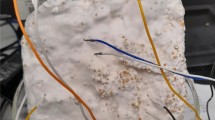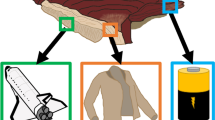Abstract
Mycelium-bound composites consist of discrete substrate elements joined together by filamentous hypha strands. These composites can be moulded or extruded into custom components of desired shapes. When live fungi are present these composites exhibit electrical conductivity as well as memfractive and capacitive properties. These composites might be used in nonlinear electrical circuits. We investigated the AC conductive properties of mycelium-bound composites and fungal fruit bodies at higher frequencies, spanning three overlapping frequency ranges: 20 Hz to 300 kHz, 10 Hz to 4 MHz, and 50 kHz to 3 GHz, to advance fungal electronics. Our measurements revealed that mycelium-bound composites primarily function as low-pass filters, with an average cut-off frequency of 500 kHz and a roll-off rate of \(-\)14 dB/decade. Within the pass band, the average attenuation is less than 1 dB. Fungal fruiting bodies have significantly lower mean cut-off frequencies that range from 5 Khz to 50 Khz depending on the species. Their roll-off range from \(-20\) to \(-30\) decibels per decade, with mean attenuation across the pass band less than 3 decibels. The precise mechanism underlying frequency-dependent attenuation is unclear. However, the high-water content, which is around 80 % in mycelium-bound composites and up to 92 % in fruiting bodies, is important. Because of the presence of dissolved ionizable solids, this water content is electrically conductive, making it a likely contributing factor. This research looks into the potential applications of mycelium-bound composites and fungal fruiting bodies in analog computing.
Access this chapter
Tax calculation will be finalised at checkout
Purchases are for personal use only
Similar content being viewed by others
References
Saez, D., Grizmann, D., Trautz, M., Werner, A.: Exploring the binding capacity of mycelium and wood-based composites for use in construction. Biomimetics 7(2) (2022)
Karana, E., Blauwhoff, D., Hultink, E.-J., Camere, S.: When the material grows: a case study on designing (with) mycelium-based materials. Int. J. Des. 12(2) (2018)
Jones, M., Mautner, A., Luenco, S., Bismarck, A., John, S.: Engineered mycelium composite construction materials from fungal biorefineries: a critical review. Mater. Des. 187, 108397 (2020)
Cerimi, K., Can Akkaya, K., Pohl, C., Schmidt, B., Neubauer, P.: Fungi as source for new bio-based materials: a patent review. Fungal Biol. Biotechnol. 6(1), 1–10 (2019)
Adamatzky, A., Ayres, P., Belotti, G., Wösten, H.: Fungal architecture position paper. Int. J. Unconv. Comput. 14 (2019)
Beasley, A.E., Powell, A.L., Adamatzky, A.: Capacitive storage in mycelium substrate (2020). arXiv:2003.07816
Beasley, A.E., Abdelouahab, M.-S., Lozi, R., Powell, A.L., Adamatzky, A.: Mem-fractive properties of mushrooms (2020). arXiv:2002.06413
Beasley, A.E., Powell, A.L., Adamatzky, A.: Fungal photosensors (2020). arXiv:2003.07825
Jones, M., Mautner, A., Luenco, S., Bismarck, A., John, S.: Engineered mycelium composite construction materials from fungal biorefineries: a critical review. Mater. Des. 187, 108397 (2020)
Soh, E., Yong Chew, Z., Saeidi, N., Javadian, A., Hebel, D., Le Ferrand, H.: Development of an extrudable paste to build mycelium-bound composites. Mater. Des. 195, 109058 (2020)
Adamatzky, A., Tegelaar, M., Wosten, H.A.B., Powell, A.L., Beasley, A.E., Mayne, R.: On boolean gates in fungal colony. Biosystems 193, 104138 (2020)
Adamatzky, A., Chiolerio, A., Sirakoulis, G.: On resistive spiking of fungi (2020). arXiv:2009.00292
Adamatzky, A., Gandia, A., Chiolerio, A.: Fungal sensing skin. Fungal Biol. Biotechnol. 8(1), 1–6 (2021)
Przyczyna, D., Szacilowski, K., Chiolerio, A., Adamatzky, A.: Electrical frequency discrimination by fungi pleurotus ostreatus (2022). arXiv:2210.01775
Phillips, N., Gandia, A., Adamatzky, A.: Electrical response of fungi to changing moisture content. TBC J. (2022)
Olsson, S., Hansson, B.S.: Action potential-like activity found in fungal mycelia is sensitive to stimulation. Naturwissenschaften 82(1), 30–31 (1995)
Adamatzky, A.: On spiking behaviour of oyster fungi pleurotus djamor. Sci. Rep. 8(1), 1–7 (2018)
Adamatzky, A., Tuszynski, J., Pieper, J., Nicolau, D.V., Rinalndi, R., Sirakoulis, G., Erokhin, V., Schnauss, J., Smith, D.M.: Towards cytoskeleton computers. A proposal. In: Adamatzky, A., Akl, S., Sirakoulis, G. (eds.) From Parallel to Emergent Computing. CRC Group/Taylor & Francis (2019)
Adamatzky, A., Ayres, P., Beasley, A.E., Roberts, N., Tegelaar, M., Tsompanas, M.-A., Wösten, H.A.B.: Logics in fungal mycelium networks (2021). arXiv:2112.07236
Shao, B., Weerasekera, R., Tareke Woldegiorgis, A., Zheng, L.-R., Liu, R., Zapka, W.: High frequency characterization and modelling of inkjet printed interconnects on flexible substrate for low-cost rfid applications. In: Electronics System-Integration Technology Conference, pp. 695–700 (2008)
Shao, B., Weerasekera, R., Zheng, L.-R., Liu, R., Zapka, W., Lindberg, P.: High frequency characterization of inkjet printed coplanar waveguides. In: IEEE Workshop on Signal Propagation on Interconnects, pp. 1–4 (2008)
Miller, A.: Oyster grain spawn (2022). https://www.annforfungi.co.uk/shop/oyster-grain-spawn/. [Online; accessed 18-Sept-2022]
Precision, B.K.: Model 891 (2022). https://www.bkprecision.pl/files/891_datasheet.pdf. [Online; accessed 18-Sept-2022]
Cypher-Instruments.: C60 network analyzer (2022). http://www.cypherinstruments.co.uk/. [Online; accessed 18-Sept-2022]
NanoRFE.: Vector network analyse, model NanoVNA-F V2 (2022). https://nanorfe.com/nanovna-v2.html. [Online; accessed 18-Sept-2022]
Danninger, D., Pruckner, R., Holzinger, L., Koeppe, R., Kaltenbrunner, M.: Myceliotronics: fungal mycelium skin for sustainable electronics. Sci. Adv. 8(45), eadd7118 (2022)
Ishtaiwi, M., Hajjyahya, M., Habbash, S.: Electrical properties of dead sea water. J. Appl. Math. Phys. 9(12), 3094–3101 (2021)
Porle, R.R., Ruslan, N.S., Ghani, N.M., Arif, N.A., Ismail, S.R., Parimon, N., Mamat, M.: A survey of filter design for audio noise reduction. J. Adv. Rev. Sci. Res. 12(1), 26–44 (2015)
Williams, A.B.: Analog Filter and Circuit Design Handbook. McGraw-Hill Education (2014)
Thiele, N.: Bandpass subwoofer design. J. Audio Eng. Soc. 62(3), 145–160 (2014)
Parhami, B.: Parallel processing with big data (2019)
Cao, K., Liu, Y., Meng, G., Sun, Q.: An overview on edge computing research. IEEE Access 8, 85714–85728 (2020)
Varghese, B., Wang, N., Barbhuiya, S., Kilpatrick, P., Nikolopoulos, D.S.: Challenges and opportunities in edge computing. In: 2016 IEEE International Conference on Smart Cloud (SmartCloud), pp. 20–26. IEEE (2016)
Krestinskaya, O., Pappachen James, A., Ong Chua, L.: Neuromemristive circuits for edge computing: a review. IEEE Trans. Neural Netw. Learn. Syst. 31(1), 4–23 (2019)
Csaba, G., Raychowdhury, A., Datta, S., Porod, W.: Computing with coupled oscillators: theory, devices, and applications. In: 2018 IEEE International Symposium on Circuits and Systems (ISCAS), pp. 1–5. IEEE (2018)
Csaba, G., Porod, W.: Coupled oscillators for computing: a review and perspective. Appl. Phys. Rev. 7(1), 011302 (2020)
Chou, J., Bramhavar, S., Ghosh, S., Herzog, W.: Analog coupled oscillator based weighted ising machine. Sci. Rep. 9(1), 1–10 (2019)
MacKay, D.M.: High-speed electronic-analogue computing techniques. Proc. IEE-Part B: Radio Electron. Eng. 102(5), 609–620 (1955)
Ronaldo da Costa Bento, C., Carlos Gomes Wille, E.: Bio-inspired routing algorithm for manets based on fungi networks. Ad Hoc Netw. 107, 102248 (2020)
Adamatzky, A., Nikolaidou, A., Gandia, A., Chiolerio, A., Mahdi Dehshibi, M.: Reactive fungal wearable. Biosystems 199, 104304 (2021)
Author information
Authors and Affiliations
Corresponding author
Editor information
Editors and Affiliations
Rights and permissions
Copyright information
© 2023 The Author(s), under exclusive license to Springer Nature Switzerland AG
About this chapter
Cite this chapter
Phillips, N., Weerasekera, R., Roberts, N., Adamatzky, A. (2023). Electrical Signal Transfer by Fungi. In: Adamatzky, A. (eds) Fungal Machines. Emergence, Complexity and Computation, vol 47. Springer, Cham. https://doi.org/10.1007/978-3-031-38336-6_16
Download citation
DOI: https://doi.org/10.1007/978-3-031-38336-6_16
Published:
Publisher Name: Springer, Cham
Print ISBN: 978-3-031-38335-9
Online ISBN: 978-3-031-38336-6
eBook Packages: Intelligent Technologies and RoboticsIntelligent Technologies and Robotics (R0)




